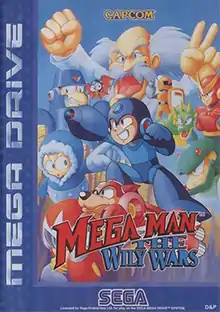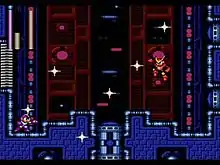Mega Man: The Wily Wars
Mega Man: The Wily Wars[lower-alpha 1] is a 1994 video game compilation by Capcom for the Sega Genesis. It features remakes of the first three Mega Man games (Mega Man, Mega Man 2, and Mega Man 3) originally released for the Nintendo Entertainment System. The Wily Wars was released in cartridge format in Japan and PAL regions. The North American Genesis version was available via the Sega Channel online service.[6][7][8] Notably, the US version of the game was rereleased as part of the Sega Genesis Mini.[9][10]
| Mega Man: The Wily Wars | |
|---|---|
 PAL cover art | |
| Developer(s) | Minakuchi Engineering |
| Publisher(s) | Capcom |
| Artist(s) | Keiji Inafune |
| Composer(s) | Kinuyo Yamashita[1] |
| Series | Mega Man |
| Platform(s) | Sega Mega Drive |
| Release | |
| Genre(s) | Action, platform |
| Mode(s) | Single-player |
Plot
The evil Dr. Wily has traveled back in time in an attempt to defeat the robotic hero Mega Man in one of their first three conflicts.[2][11] Each game follows Mega Man reliving his past adventures in which Wily dispatches a set of powerful robots to take over the world which must be single-handedly stopped as before. After completing his travels through time, Mega Man must use all he has learned to tackle the Wily Tower.
Gameplay

All three games have the player control Mega Man (Rockman in Japan) through a series of platform stages which can be completed in any order. At the end of each stage is a boss battle with a Robot Master. The player will acquire that Robot Master's special weapon, which can then be selected and used throughout the rest of the game. Each game also features one or more support items that aid the player in reaching places the player cannot reach by normal means. Each Master Weapon and support item has limited energy that can be replenished by picking up items left by fallen enemies.
The compilation features an upgrade to the original games' visuals, as well as arranged music.[6][12] An important change is that the compilation provides battery back-up for each game. As a result, it is possible to continue Mega Man from a later point in the game, though Mega Man 2 and Mega Man 3 lost the password feature. The Wily Wars removes several glitches present in the NES versions of the game.[13] Upon completion of all three games, an exclusive game mode, called "Wily Tower", is made available to the player. In Wily Tower, Mega Man travels through three different stages fighting against a trio of new bosses called the "Genesis Unit", which are based on characters from the Great Classical Novel Journey to the West: Buster Rod.G (Sun Wukong), Mega Water.S (Sha Wujing), and Hyper Storm.H (Zhu Bajie).[13] After they are defeated, the player finally faces Wily in the titular tower. Wily Tower requires the player to equip Mega Man with eight weapons and three support items from any of the three main games to proceed.
Development
Artist Keiji Inafune claimed that the development of Mega Man: The Wily Wars was outsourced and rather slowgoing. He described the debugging procedure for The Wily Wars as "an absolute nightmare", even helping out in the process himself. "It was so bad," he recalled, "I found myself saying, 'I can't believe we've made it out of there alive.'"[2] Inafune based his designs of the three new Wily Tower bosses on characters from the ancient Chinese novel Journey to the West. Other than these characters, Inafune's only other illustrative contribution to the game was the depiction of Mega Man and Rush on the cover art.[2] The soundtrack of The Wily Wars consists of 16-bit versions of the original Mega Man musical scores, as well as new songs for the Wily Tower portion of the game. The composer for the Wily Wars has not been officially credited by Capcom. According to the game's sound effects creator Kouji Murata, Kinuyo Yamashita was responsible for the music composition and arrangement.[1]
Following the success of Street Fighter II′: Special Champion Edition on the Mega Drive/Genesis, rumors began circulating in the United States early 1994 that a Mega Man game was in the works for Sega's 16-bit system, the Sega Genesis.[14] The Wily Wars was displayed by Sega of America at the Sega Summit sales meeting in May of that same year.[15] The Wily Wars was first released in Japan on October 21, 1994.[2] It was the first Mega Man game to be released on a non-Nintendo console.[16] The United States magazine Game Players reported in its October issue that the North American release The Wily Wars was put on hold indefinitely due to graphical problems.[17] The April 1996 issue of GamePro reported that it had been cancelled.[18] However, the game was released in a non-cartridge format on the Sega Channel, a paid subscription service for Genesis games.[6]
Reception and legacy
Critical reception for Mega Man: The Wily Wars has been favorable. Christian Nutt and Justin Speer of GameSpot stated that the game is "a must for any serious Mega Man fan".[6] Sega-16 contributor Robert Menes summarized, "Although there's a few flaws that keep this from being an absolute must have, it's still Mega Man, and Mega Man games are among some of the best and brightest platformer series."[13] Jeremy Parrish of 1UP.com labeled Mega Man: The Wily Wars as "Not Worth It!" because certain design issues prevent it from aging as well as the NES versions of the games.[20] Mega Man: The Wily Wars has consistently ranked high among the editors of Nintendo Power as a game they would like to see on the Wii Virtual Console service.[21][22][23]
Elements of the game were adapted into the Archie Comics Mega Man series, with issue 20 notably including an opening that seemed to be leading into the game with the inclusion of the Genesis Unit and Mega Man Killers while issue 55 involves Dr. Light having a vision of the game's conflict.
In 2012, Mega Man: The Wily Wars was included on the "Ultimate Portable Game Player" compilation, a portable device with 80 built-in Sega Genesis games.[24] On May 16, 2019, Sega announced that Mega Man: The Wily Wars would be rereleased as one of the games included in the Sega Genesis Mini.[25]
References
- released in Japan as Rockman Mega World (ロックマン メガワールド)
- Murata, Kouji. "これまでの仕事 / Works". ゲのつく仕事 (in Japanese). Archived from the original on September 2, 2011. Retrieved 2011-08-18.
- Mega Man: Official Complete Works. Udon Entertainment. January 6, 2010. p. 77. ISBN 978-1-897376-79-9.
- "ProNews: Wily Wars Hits Sega Channel". GamePro. No. 67. IDG. February 1995. p. 162. ISSN 1042-8658. Retrieved 2019-05-20.
- Appel, Markus (April 1995). "Test Mega Drive - Mega Man Wily Wars". Mega Fun (in German). No. 31. CT Computec Verlag GmbH & Co. KG. p. 71. ISSN 0946-6282. Retrieved 2019-05-20.
- "April Release on Mega Drive - Mega Man The Wily Wars" (PDF). New Releases Catalogue. Sega. April 1995. p. 9. Retrieved 2019-05-20.
- Nutt, Christian & Speer, Justin (November 6, 2003). "The History of Mega Man". GameSpot. Archived from the original on December 16, 2009. Retrieved April 17, 2010.
- Gazza, Brian (November 27, 2008). "The Sega Channel". blamethecontrolpad.com. Archived from the original on 2014-12-09. Retrieved 2019-05-16.
- Buchanan, Levi (June 11, 2008). "The SEGA Channel". IGN. Archived from the original on August 30, 2012. Retrieved May 9, 2010.
- SEGA. "Genesis Mini". genesismini.sega.com. Retrieved 2019-09-02.
- Carter, Chris (April 16, 2019). "Rare US Release Mega Man: The Wily Wars Returns on the Sega Genesis". Destructoid. Retrieved 2019-12-09.
- Capcom, ed. (October 1994). Mega Man: The Wily Wars Instruction Booklet (PDF). Capcom Entertainment, Inc. p. 8.
I should have melted that meddling robot years ago. But now, with the help of my new Wily machine, I'm going to fix that. I'll just take a quick blast to the past, and I'll make sure that Mega Man will never have survived any of our first three encounters! With Mega Man destroyed in the past, there will be nothing to stop me here in the future. The world will finally be mine!!!
- "ProNews" (PDF). GamePro. No. 60. Infotainment World, Inc. July 1994. p. 168.
- Menes, Robert (May 15, 2006). "Review: Mega Man: The Wily Wars". Sega-16.com. Archived from the original on June 14, 2013. Retrieved May 10, 2010.
- "Mega Man for the Mega Drive?" (PDF). Mega. No. 16. Future Publishing. January 1994. p. 8. ISSN 0966-6206.
- Greenstein, Jane (May 20, 1994). "Big retailers to see Sega game preview. (1994 'Sega Summit' sales meeting sponsored by Sega of America Inc.)". Video Business. Retrieved May 9, 2010.
- Wil Overton (April 1995). "Viva Le Mega Man". Super Play. Future Publishing (30): 30–1. ISSN 0966-6192.
- "News: Chatter" (PDF). Game Players. Imagine Media. 7 (10): 16. October 1994. ISSN 1091-1685.
- "The State of the 16-Bit World: Cancelled Games". GamePro. No. 91. IDG. April 1996. p. 44.
- Famitsu staff (1994). "クロスレビュー" [Cross Review]. Famitsu (in Japanese). Tokuma Shoten. Archived from the original on March 24, 2019. Retrieved March 24, 2019.
- Parish, Jeremy (May 10, 2007). "The Mega Man Series Roundup". 1UP.com. Archived from the original on July 21, 2012. Retrieved April 10, 2010.
- "Most Wanted". Nintendo Power. No. 229. Future US. June 2008. ISSN 1041-9551.
- "Most Wanted". Nintendo Power. No. 235. Future US. December 2008. ISSN 1041-9551.
- "Most Wanted". Nintendo Power. No. 245. Future US. September 2009. ISSN 1041-9551.
- "Portable Sega Genesis With Mega Man: The Wily Wars Coming This Month". November 5, 2012.
- Plante, Chris (2019-05-16). "Sega confirms 10 more Genesis Mini games, including a rare Mega Man". Polygon. Retrieved 2020-04-10.